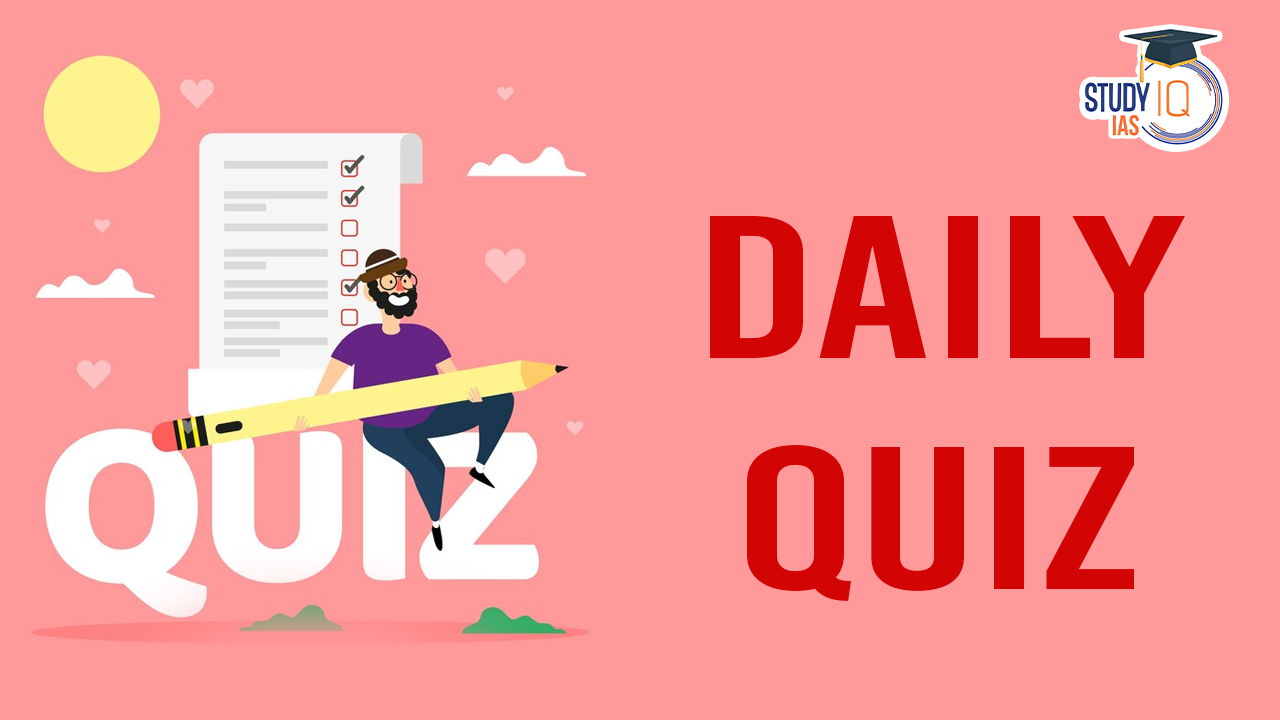Daily Quiz 07 August 2025
Quiz-summary
0 of 5 questions completed
Questions:
- 1
- 2
- 3
- 4
- 5
Information
- Click on – ‘Start Quiz’ button
- Solve Questions
- Click on ‘Next’ button
- Click on ‘Finish Quiz’ button
- Now click on ‘View Questions’ button – here you will see solutions and links.
- The test contains a total of 5 questions.
- Click on the most appropriate option to mark it as your answer.
- You will be awarded Two marks for each correct answer.
- You can change your answer by clicking on some other option.
- A Number list of all questions appears at the top side of the screen.
- You can access the questions in any order by clicking on the question number given on the number list.
- You can use rough sheets while taking the test.
- Do not use calculators, log tables, dictionaries, or any other printed/online reference material during the test.
- Do not click the button “Finish Quiz” before completing the test. A test once submitted cannot be resumed.
You have already completed the quiz before. Hence you can not start it again.
Quiz is loading...
You must sign in or sign up to start the quiz.
You have to finish following quiz, to start this quiz:
- 1
- 2
- 3
- 4
- 5
- Answered
- Review
-
Question 1 of 5
1. Question
1 pointsRegarding Deep Brain Stimulation (DBS), consider the following statements:
1. It involves implanting electrodes into the brain to stimulate specific regions.
2. DBS can treat both neurological and psychiatric disorders.
3. The effects of DBS are permanent and irreversible.
How many of the statements given above are incorrect?Correct
Answer: A
Explanation:
• Statement 1 – Correct: DBS involves surgically implanting electrodes into targeted brain areas. These are connected to a pulse generator (like a pacemaker), which delivers controlled electrical impulses to regulate abnormal brain activity.
• Statement 2 – Correct: DBS is used to treat neurological disorders like Parkinson’s disease, dystonia, and essential tremor, and also shows promise for psychiatric conditions such as OCD and depression.
• Statement 3 – Incorrect: DBS is non-destructive and reversible. If the device is turned off, the stimulation stops immediately, and its effects can be modified or reversed without permanent brain damage, unlike ablative surgeries.Incorrect
Answer: A
Explanation:
• Statement 1 – Correct: DBS involves surgically implanting electrodes into targeted brain areas. These are connected to a pulse generator (like a pacemaker), which delivers controlled electrical impulses to regulate abnormal brain activity.
• Statement 2 – Correct: DBS is used to treat neurological disorders like Parkinson’s disease, dystonia, and essential tremor, and also shows promise for psychiatric conditions such as OCD and depression.
• Statement 3 – Incorrect: DBS is non-destructive and reversible. If the device is turned off, the stimulation stops immediately, and its effects can be modified or reversed without permanent brain damage, unlike ablative surgeries. -
Question 2 of 5
2. Question
1 pointsConsider the following statements:
Statement I: The Gini Index is a comprehensive and fully accurate measure of income inequality in India.
Statement II: The Gini Index does not capture wealth inequality or informal sector income in India.
Statement III: Intersectional inequalities such as gender, caste, and digital divide are not reflected in the Gini Index calculations.
Which one of the following is correct in respect of the above statements?
Correct
Answer: A
Explanation:
- Statement I is incorrect. While the Gini Index is widely used to measure income inequality, it is not fully accurate or comprehensive for India because it excludes large parts of the informal sector, wealth concentration, and intersectional inequalities.
- Statement II is correct. The Gini Index primarily measures income inequality based on reported incomes and tax data, which underrepresent India’s informal sector (employing over 90% of the workforce) and ignores wealth inequality altogether. The editorial notes that India’s top 1% holds a large share of national wealth that Gini misses.
- Statement III is also correct. The Gini Index does not factor in inequalities based on gender, caste, regional disparities, or digital access, all critical in India’s socio-economic context. For example, digital divides affect economic participation but are invisible to the Gini metric.
Therefore, Statements II and III explain why Statement I is misleading, showing that despite India’s low Gini score (suggesting equality), the lived realities reveal significant and layered inequalities.
Incorrect
Answer: A
Explanation:
- Statement I is incorrect. While the Gini Index is widely used to measure income inequality, it is not fully accurate or comprehensive for India because it excludes large parts of the informal sector, wealth concentration, and intersectional inequalities.
- Statement II is correct. The Gini Index primarily measures income inequality based on reported incomes and tax data, which underrepresent India’s informal sector (employing over 90% of the workforce) and ignores wealth inequality altogether. The editorial notes that India’s top 1% holds a large share of national wealth that Gini misses.
- Statement III is also correct. The Gini Index does not factor in inequalities based on gender, caste, regional disparities, or digital access, all critical in India’s socio-economic context. For example, digital divides affect economic participation but are invisible to the Gini metric.
Therefore, Statements II and III explain why Statement I is misleading, showing that despite India’s low Gini score (suggesting equality), the lived realities reveal significant and layered inequalities.
-
Question 3 of 5
3. Question
1 pointsWith reference to the Kudavolai System, an ancient electoral practice of the Chola Empire, consider the following statements:
- It used a lottery-like system to ensure impartial selection of officials.
- Candidates were required to be well-versed in the Vedas or administrative texts.
- It allowed re-election of the same person consecutively for multiple terms.
Which of the statements given above is/are correct?
Correct
Answer: A
Explanation:
- Statement 1 – Correct: The Kudavolai system used a ballot pot, in which names of eligible candidates were written on palm leaves. A neutral child would draw the lot publicly—ensuring fairness and transparency in elections.
- Statement 2 – Correct: Candidates had to meet strict eligibility criteria, including literacy in Vedic or administrative texts, ensuring that governance remained with the qualified and learned.
Statement 3 – Incorrect: The system discouraged consecutive re-election, aiming to prevent dynastic control and corruption. There were strong disqualification norms, with penalties for unethical behavior, as recorded in Chola inscriptions.
Incorrect
Answer: A
Explanation:
- Statement 1 – Correct: The Kudavolai system used a ballot pot, in which names of eligible candidates were written on palm leaves. A neutral child would draw the lot publicly—ensuring fairness and transparency in elections.
- Statement 2 – Correct: Candidates had to meet strict eligibility criteria, including literacy in Vedic or administrative texts, ensuring that governance remained with the qualified and learned.
Statement 3 – Incorrect: The system discouraged consecutive re-election, aiming to prevent dynastic control and corruption. There were strong disqualification norms, with penalties for unethical behavior, as recorded in Chola inscriptions.
-
Question 4 of 5
4. Question
1 pointsWith reference to the Badaga community of Tamil Nadu, consider the following statements:
- The Badaga language is a dialect of Kannada and is written only in the Tamil script.
- The community celebrates a harvest festival called Devahabba, involving white-clad processions and community prayers.
- The Badagas traditionally live in compact village clusters called “hattis” in the Nilgiris.
How of the statements given above are correct?
Correct
Answer: B
Explanation:
- Statement 1 – Incorrect: While Badaga is a dialect of Kannada, it is written in both Tamil and Kannada scripts, depending on the context and education level of the user. It is not limited to just the Tamil script.
- Statement 2 – Correct: Devahabba (literally “Festival of the Gods”) is the Badaga community’s traditional harvest festival, characterized by white-clad processions, collective worship, and ritual thanksgiving for a successful crop cycle.
Statement 3 – Correct: The Badagas live in small, densely clustered hill villages called “hattis”, where homes are built with stone walls and thatched or tiled roofs, reflecting their indigenous architectural style.
Incorrect
Answer: B
Explanation:
- Statement 1 – Incorrect: While Badaga is a dialect of Kannada, it is written in both Tamil and Kannada scripts, depending on the context and education level of the user. It is not limited to just the Tamil script.
- Statement 2 – Correct: Devahabba (literally “Festival of the Gods”) is the Badaga community’s traditional harvest festival, characterized by white-clad processions, collective worship, and ritual thanksgiving for a successful crop cycle.
Statement 3 – Correct: The Badagas live in small, densely clustered hill villages called “hattis”, where homes are built with stone walls and thatched or tiled roofs, reflecting their indigenous architectural style.
-
Question 5 of 5
5. Question
1 pointsThe phenomenon of gold remaining solid even when superheated far beyond its melting point challenges which of the following established principles?
Correct
Answer: C
Explanation:
- In normal thermodynamic conditions, heating a solid beyond its melting point should cause it to transition into the liquid phase, due to entropy increase (disorder).
- However, scientists observed that gold stayed solid even at 14 times its melting point (~14,000°C) when rapidly heated. This temporary “superheated solid” state occurred because the heating was so fast (in trillionths of a second) that atomic rearrangement (melting) didn’t have time to occur.
This challenges the Second Law of Thermodynamics, which states that systems evolve toward increasing entropy, and that solids should melt when enough heat is applied, given sufficient time.
Incorrect
Answer: C
Explanation:
- In normal thermodynamic conditions, heating a solid beyond its melting point should cause it to transition into the liquid phase, due to entropy increase (disorder).
- However, scientists observed that gold stayed solid even at 14 times its melting point (~14,000°C) when rapidly heated. This temporary “superheated solid” state occurred because the heating was so fast (in trillionths of a second) that atomic rearrangement (melting) didn’t have time to occur.
This challenges the Second Law of Thermodynamics, which states that systems evolve toward increasing entropy, and that solids should melt when enough heat is applied, given sufficient time.
Results
0 of 5 questions answered correctly
Your time:
Time has elapsed
You have reached 0 of 0 points, (0)
| Average score |
|
| Your score |
|
Categories
- Not categorized 0%
| Pos. | Name | Entered on | Points | Result |
|---|---|---|---|---|
| Table is loading | ||||
| No data available | ||||
Sharing is caring!


 Daily Quiz 18 September 2025
Daily Quiz 18 September 2025

























